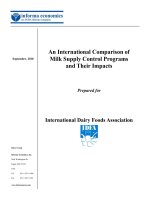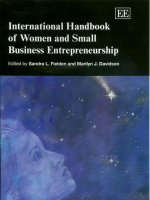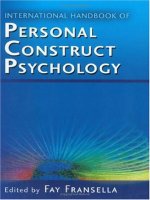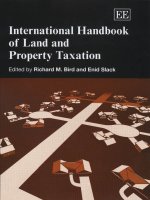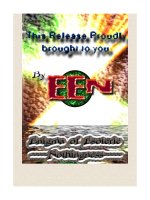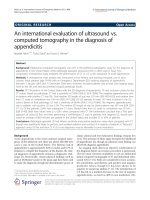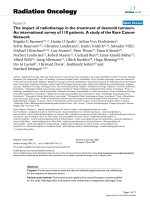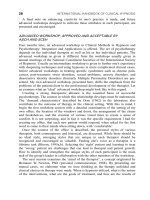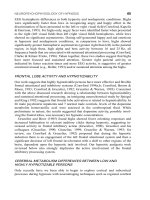An international handbook of tourism education
Bạn đang xem bản rút gọn của tài liệu. Xem và tải ngay bản đầy đủ của tài liệu tại đây (2.86 MB, 539 trang )
AN INTERNATIONAL HANDBOOK OF
TOURISM EDUCATION
i
ADVANCES IN TOURISM RESEARCH
Series Editor: Professor Stephen J. Page
University of Stirling, U.K.
Advances in Tourism Research series publishes monographs and edited volumes that comprise state-of-the-art
research findings, written and edited by leading researchers working in the wider field of tourism studies. The
series has been designed to provide a cutting edge focus for researchers interested in tourism, particularly the
management issues now facing decision-makers, policy analysts and the public sector. The audience is much
wider than just academics and each book seeks to make a significant contribution to the literature in the field of
study by not only reviewing the state of knowledge relating to each topic but also questioning some of the prevailing assumptions and research paradigms which currently exist in tourism research. The series also aims to
provide a platform for further studies in each area by highlighting key research agendas which will stimulate further debate and interest in the expanding area of tourism research. The series is always willing to consider new
ideas for innovative and scholarly books, inquiries should be made directly to the Series Editor.
Recent published titles in this series include:
PIKE
Destination Marketing Organisations
THOMAS
Small Firms in Tourism: International Perspectives
LUMSDON & PAGE
Tourism and Transport
KERR
Tourism Public Policy and the Strategic Management of Failure
WILKS & PAGE
Managing Tourist Health and Safety in the New Millennium
Forthcoming titles include:
RYAN & AICKEN
Indigenous Tourism
RYAN, PAGE & AICKEN
Taking Tourism to the Limits
WILKS, PENDERGAST & LEGGAT
Tourism in Turbulent Times
LENNON, SMITH, COCKEREL & TREW
Benchmarking National Tourism Organisations and Agencies
BALDACCHINO
Cold Water Tourism
Related Elsevier Journals — sample copies available on request
Annals of Tourism Research
International Journal of Hospitality Management
Tourism Management
World Development
ii
AN INTERNATIONAL
HANDBOOK OF TOURISM
EDUCATION
EDITED BY
DAVID AIREY and JOHN TRIBE
University of Surrey, U.K.
2005
Amsterdam – Boston – Heidelberg – London – New York – Oxford
Paris – San Diego – San Francisco – Singapore – Sydney – Tokyo
iii
ELSEVIER B.V.
Radarweg 29
P.O. Box 211, 1000 AE
Amsterdam, The Netherlands
ELSEVIER Inc.
525 B Street, Suite 1900
San Diego, CA 92101-4495
USA
ELSEVIER Ltd
The Boulevard, Langford Lane
Kidlington, Oxford OX5 1GB
UK
ELSEVIER Ltd
84 Theobalds Road
London WC1X 8RR
UK
© 2005 Elsevier Ltd. All rights reserved.
This work is protected under copyright by Elsevier Ltd, and the following terms and conditions apply to its use:
Photocopying
Single photocopies of single chapters may be made for personal use as allowed by national copyright laws. Permission
of the Publisher and payment of a fee is required for all other photocopying, including multiple or systematic copying,
copying for advertising or promotional purposes, resale, and all forms of document delivery. Special rates are available
for educational institutions that wish to make photocopies for non-profit educational classroom use.
Permissions may be sought directly from Elsevier’s Rights Department in Oxford, UK: phone (+44) 1865 843830, fax
(+44) 1865 853333, e-mail: Requests may also be completed on-line via the Elsevier homepage ( />In the USA, users may clear permissions and make payments through the Copyright Clearance Center, Inc., 222
Rosewood Drive, Danvers, MA 01923, USA; phone: (+1) (978) 7508400, fax: (+1) (978) 7504744, and in the UK
through the Copyright Licensing Agency Rapid Clearance Service (CLARCS), 90 Tottenham Court Road, London W1P
0LP, UK; phone: (+44) 20 7631 5555; fax: (+44) 20 7631 5500. Other countries may have a local reprographic rights
agency for payments.
Derivative Works
Tables of contents may be reproduced for internal circulation, but permission of the Publisher is required for external
resale or distribution of such material. Permission of the Publisher is required for all other derivative works, including
compilations and translations.
Electronic Storage or Usage
Permission of the Publisher is required to store or use electronically any material contained in this work, including any
chapter or part of a chapter.
Except as outlined above, no part of this work may be reproduced, stored in a retrieval system or transmitted in any form
or by any means, electronic, mechanical, photocopying, recording or otherwise, without prior written permission of the
Publisher.
Address permissions requests to: Elsevier’s Rights Department, at the fax and e-mail addresses noted above.
Notice
No responsibility is assumed by the Publisher for any injury and/or damage to persons or property as a matter of products
liability, negligence or otherwise, or from any use or operation of any methods, products, instructions or ideas contained
in the material herein. Because of rapid advances in the medical sciences, in particular, independent verification of diagnoses and drug dosages should be made.
First edition 2005
British Library Cataloguing in Publication Data
A catalogue record is available from the British Library.
ISBN: 0-08-044667-1
The paper used in this publication meets the requirements of ANSI/NISO Z39.48-1992 (Permanence of Paper).
Printed in The Netherlands.
Working together to grow
libraries in developing countries
www.elsevier.com | www.bookaid.org | www.sabre.org
iv
Contents
Contributors
ix
Introduction
1.
Introduction
John Tribe and David Airey
3
2.
Growth and Development
David Airey
13
3.
Overview of Research
John Tribe
25
Curriculum
4.
Tourism, Knowledge and the Curriculum
John Tribe
47
5.
Curriculum Theory and Practice: A Case in On-line Education
Sheryl Elliott and Ginger Smith
61
6.
Curriculum, Development and Conflict: A Case Study of Moldova
John Tribe
77
7.
Work Experience and Industrial Links
Graham Busby
93
International Tourism Education
8.
Australasia
Brian King and Stephen Craig-Smith
111
9.
Brazil and Latin America
Sérgio Leal and Maria Auxiliadora Padilha
123
v
vi
Contents
10. The Caribbean
Acolla Lewis
133
11. China
Wen Zhang and Xixia Fan
149
12. East Africa
Melphon Mayaka
161
13. Germany
Walter Freyer, Michael Hammer and Astrid Piermeier
173
14. India
Shalini Singh and Tej Vir Singh
191
15. The Netherlands
Magiel Venema
211
16. North America
Simon Hudson
223
17. Slovenia
Tanja Mihalic
241
18. South Africa
Melville Saayman
257
19. United Kingdom
David Airey
271
Teaching, Learning and Assessment
20. Teaching
Dimitrios Stergiou
285
21. The Student Experience
Eugenia Wickens and Alastair Forbes
299
22. Issues in Teaching and Learning
Brian Wheeller
309
23. Assessment
Nina Becket
319
Contents
vii
24. Undergraduate Dissertations
Karen A. Smith
337
25. Cultural Issues in Learning
Paul Barron
353
26. e-Learning and e-Assessment
Marianna Sigala
367
27. Teaching and Research
Fiona Jordan
383
28. Community Education
Stroma Cole
395
Resources, Progression and Quality
29. Teachers
Marion Stuart-Hoyle
411
30. Learning Resources
Lyn Bibbings
425
31. Careers and Employment
Adele Ladkin
437
32. Quality Assurance
Derek Robbins
451
33. Postgraduate and Ph.D. Education
David Botterill and Tim Gale
469
Postscript
34. Practical Issues for Design, Delivery, Evaluation and Resourcing of Courses
Miriam Moir and Lisa Hodgkins
483
35. Issues for the Future
David Airey and John Tribe
501
Author Index
507
Subject Index
519
This page intentionally left blank
viii
Contributors
David Airey
University of Surrey, Guildford, Surrey, UK
Paul Barron
School of Tourism and Leisure Management, The University of Queensland, Australia
Nina Becket
Higher Education Academy Network for Hospitality, Leisure, Sport and Tourism, Oxford
Brookes University, Oxford, UK
Lyn Bibbings
Department of Hospitality, Leisure and Tourism Management, Oxford Brookes University,
Oxford, UK
David Botterill
Welsh School of Hospitality Tourism and Leisure Management, University of Wales
Institute Cardiff, Cardiff, UK
Graham Busby
Plymouth Business School, University of Plymouth, Plymouth, UK
Stroma Cole
Faculty of Leisure & Tourism, Buckinghamshire Chilterns University College, High
Wycombe, UK
Stephen Craig-Smith
The University of Queensland, Ipswich, Queensland, Australia
Sheryl Elliot
Department of Tourism and Hospitality Management, School of Business, The George
Washington University, Washington, DC, USA
Xixia Fan
School of Tourism Management, Beijing International Studies University, Beijing, PR China
Alastair Forbes
Faculty of Leisure & Tourism, Buckinghamshire Chilterns University College, High
Wycombe, UK
ix
x
Contributors
Walter Freyer
Department of Tourism Economics and Management, Technical University of Dresden,
Dresden, Germany
Tim Gale
University of the West of England, Bristol, UK
Michael Hammer
Chair of Tourism Economics and Management, Technical University of Dresden, Dresden,
Germany
Lisa Hodgkins
Learning Resources Centre, Buckinghamshire Chilterns University College, High
Wycombe, UK
Simon Hudson
Haskayne School of Business, Calgary, Alberta, Canada
Fiona Jordan
University of Gloucestershire, Gloucester, UK
Brian King
School of Hospitality, Tourism and Marketing, Faculty of Business & Law, Victoria
University, Melbourne, Victoria, Australia
Adele Ladkin
Bournemouth University, Fern Barrow, Poole, Dorset, UK
Sérgio Leal
University of Surrey, Guildford, Surrey, UK and Faculdades Integradas da Vitória de Santo
Antão, Pernambuco, Brazil
Acolla Lewis
Department of Management Studies, University of the West Indies, St. Augustine,
Trinidad
Melphon Mayaka
Department of Hospitality and Tourism Management, Kenyatta University, Nairobi, Kenya
Tanja Mihalic
Faculty of Economics, University of Ljubljana, Ljubljana, Slovenia
Miriam Moir
Faculty of Leisure & Tourism, Buckinghamshire Chilterns University College, High
Wycombe, UK
Maria Auxiliadora Padilha
Faculdades Integradas da Vitória de Santo Antão, Pernambuco, Brazil
Contributors
xi
Astrid Piermeier
University of Regensburg, Regensburg, Germany
Derek Robbins
School of Services Management, Bournemouth University, Poole, Dorset, UK
Melville Saayman
Institute for Tourism and Leisure Studies, North West University, Potchefstroom, South
Africa
Marianna Sigala
The Business School, University of the Aegean, Chios, Greece
Shalini Singh
Brock University, St. Catharines, Ontario, Canada
Tej Vir Singh
Centre for Tourism Research & Development, Indira Nagar, Lucknow, India
Ginger Smith
Department of Tourism and Hospitality Management, School of Business, The George
Washington University, Washington, DC, USA
Karen A. Smith
Victoria Management School, Victoria University of Wellington, Wellington,
New Zealand
Dimitrios Stergiou
Technological Educational Institute of Patras, Patras, Greece
Marion Stuart-Hoyle
Canterbury Christ Church University College, Canterbury, Kent, UK
John Tribe
School of Management, University of Surrey, Guildford, UK
Magiel Venema
NHTV, Breda University for Professional Education, Breda, Netherlands
Brian Wheeller
NHTV, Breda University for Professional Education, Breda, Netherlands
Eugenia Wickens
Faculty of Leisure & Tourism, Buckinghamshire Chilterns University College, High
Wycombe, UK
Wen Zhang
School of Tourism Management, Beijing International Studies University, Beijing,
PR China
This page intentionally left blank
xii
INTRODUCTION
1
This page intentionally left blank
2
Chapter 1
Introduction
John Tribe and David Airey
Rationale and Aims
For some observers, “tourism higher education” might appear to be a term containing
mutually exclusive words. Surely tourism cannot merit study at a higher level of education? Indeed in the UK, tourism degrees are sometimes bundled (particularly by opportunist politicians) into a category of deep disdain under the heading of Mickey Mouse
Degrees. But new courses have often struggled for due recognition in the academy which
is inherently conservative and traditional. For example Silver (1990, p. 131) reports that
the UK CNAA (Council for National Academic Awards) board expressed considerable
angst about new degree proposals:
I remember housing studies for example, was one of the crunch points as
to whether you could actually make a degree of something of that kind.
And then people would point to odd things like paper technology that
some of the universities had had for years and said, well what’s odd about
housing studies.
Housing studies is now an established part of higher education, but the question as to
whether tourism is a serious or worthy area for study still hangs in the air. It is this question that provides an initial impetus for this book. With regard to the maturity of the subject, Hall and Page (2002) note that social science scholarship on tourism can be traced
back to the 1920s in the USA and Europe while in Chapter 2 of this book Airey finds an
example of individual scholarship on tourism dating back to 1891. However, the major
growth in the subject has occurred relatively recently since the mid-1980s and this provides the second impetus for the book. The time is ripe for a comprehensive description,
analysis and evaluation of the state of tourism education at the international level. The final
rationale for the book is to provide those involved in tourism education with guidance on
how other people are approaching the task as well as offering some practical tips on
design, delivery and review of courses.
An International Handbook of Tourism Education
Copyright © 2005 by Elsevier Ltd.
All rights of reproduction in any form reserved
ISBN: 0-08-044667-1
3
4
John Tribe and David Airey
The aims of the book are captured in the section headings. First, the introduction offers
a detailed account of the growth and development of the tourism studies and a review of
the literature on tourism education. Second, the crucial issue of curriculum for tourism is
unpacked. Third, authors from around the world provide the basis for a comparative analysis of tourism education by providing commentaries from a variety of national and/or
regional contexts. Fourth, the “chalk-face” issues of teaching, learning and assessment in
tourism are reviewed. Fifth, issues surrounding resources, progression and quality are discussed and finally the state of the art of tourism education is evaluated and key issues for
the future are identified.
The rest of this chapter will provide a more detailed introduction to, and overview of,
the issues discussed in the various headings.
Introduction
The remainder of the introduction starts with Chapter 2, where David Airey initially charts
the development of tourism as a distinct area of study and notes three significant developments. First, there has been a massive increase in the numbers of students, institutions and
teachers of tourism. Second, the curriculum has broadened beyond the vocational and
tourism has emerged as a subject for study at many different levels of education. Third, this
growth and change has led to tensions in the development of the curriculum. On the one
hand, Airey sees the danger of excess vocationalism where tourism education does little
more than provide a reflection of the world of work. On the other, he cautions against
tourism education turning its back on its industry connections as this would jeopardise one
of its key raisons d’etre.
In Chapter 3, John Tribe evaluates the literature on tourism education. He initially identifies the size of, and trends in, tourism education research and argues that the growing literature on tourism education (at least 302 articles up to 2001) and the existence of three
educational journals specific to the field are important indicators of the growing maturity
of tourism as an academic subject. Second, he finds that tourism education research has
particularly focussed on curriculum issues which have accounted for 86 per cent of the
total. Tribe concludes that, for the future a greater attention to methodological issues is
required and more research into effective learning and assessment is needed. Additionally
he notes that progression into tourism education and issues of widening participation are
under-researched and that there is a lack of evaluative and prescriptive literature on
resources and quality.
Curriculum
The starting point for this section is the critical analysis of the tourism curriculum provided
by John Tribe in Chapter 4. He argues that since curriculum design involves framing in curriculum space, and therefore choice, then any curriculum must be contestable. The main
contest is about what knowledge should be included, so Tribe analyses the relationship
Introduction
5
between tourism, knowledge and the curriculum. He subsequently considers the basic principles of curriculum design and explores a number of theoretical positions in order to evaluate a number of proposals that have been made for a tourism curriculum. A recurrent theme
in the chapter is that of the schisms that exist in each of the areas of tourism, knowledge and
the curriculum. On the one hand, Tribe notes that tourism, knowledge and the curriculum
may be bounded by a business and vocationalist view of things. But he also holds out the
prospect for tourism education as a means for understanding and responsible action in more
widely drawn, complex world of tourism.
Chapters 5 and 6 provide case studies in curriculum development. In Chapter 5, Sheryl
Elliott and Ginger Smith offer a case study on online education that illustrates curriculum
theory and practice. Their case study describes the establishment of the Accelerated
Master’s of Tourism Administration (AMTA) by the Department of Tourism and
Hospitality Management at George Washington University, Washington, DC. Here they
describe how the degree programme was brought fully online and includes a multimedia
animated audio/visual lecture component. In Chapter 6, John Tribe presents a case study,
which examines the process and products of a tourism curriculum development and innovation project for a University in Moldova. Tribe elaborates a method for curriculum
design and development based on strategic management techniques. Specifically he
describes three aspects of situational analysis that were used a needs analysis, a capability analysis and a force field analysis and outlines the curriculum that was agreed
based on this analysis. However, Tribe also offsets this “success” of the project with a critical evaluation and offers an alternative “failure” reading of the outcomes. On this latter
view, the influence of Western hegemony and neo-colonial development is surfaced and
flagged as a particularly poignant issue for countries such as Moldova who have only
recently escaped the grip of a strict regime of Soviet ideology. Indeed this chapter can also
offer an interesting critical–reflexive insight into the use of the term “international” in the
title of this text. It reminds us that although this text is international in its content, its overall outlook is heavily saturated by the situatedness of its editors (country, ethnicity, university, gender, class, etc.).
Finally, work placement (sandwich year, internship) is a common feature of the curriculum in tourism programmes and Graham Busby investigates this topic in Chapter 7. Busby
reviews the concept and its implementation and identifies the key attributes and aspects of
good practice that make for a successful work experience programme. The discussion is
illustrated with students’ accounts of their experiences during their placements.
International Tourism Education
The section on international tourism education offers insights into provision in 12 countries and regions representing a range of different contexts. These chapters consider issues
such as size and development, government policy and structures, curriculum, teaching and
learning, assessment, research and quality issues.
In Chapter 8, Brian King and Stephen Craig-Smith assess the situation in Australasia.
Here they offer a picture of a rise in tourism education in both Australia and New Zealand
to a position where the majority of public universities in the two countries now offer
6
John Tribe and David Airey
tourism and/hospitality degree programmes. The development and funding of the
Sustainable Tourism Co-operative Research Centre, a partnership between universities,
governments and tourism enterprises is identified as a key factor that has enabled Australia
to compete strongly in the international arena in tourism research. King and Craig-Smith
also note that international tourism student enrolments have grown rapidly in both countries largely due to the proximity of the expanding Asian student market and the attractiveness of Australasia as a place to study. An interesting point of comparison arises here
with the situation in North America (see Chapter 16), where Simon Hudson describes a
decline in international post-graduate enrolment.
Chapter 9 provides a contrast where Sérgio Leal and Maria Auxiliadora Padilha examine the situation in Brazil and Latin America. They find tourism education and research in
this region to be in its early stages of development. There is little attention paid to the
development of qualified professionals working in the sector and only a modest participation of scholars from the region in the international academic community. In Brazil however they find that tourism education and research have rapidly expanded, encouraged by
the fast growth of the industry and enabled by the liberalisation of the education sector.
The authors note a concomitant growth in the number of specialised publications and
research degree programmes but point to the lack of a subject association that would support the development of tourism education.
For the Caribbean, as Acolla Lewis reminds us in Chapter 10, tourism is the “lifeblood”
of the majority of the islands. Despite this, Lewis notes that tourism education and training has come under intense criticism with respect to the governance and operation of the
institutions as well as the quality of the programmes. However, she sees grounds for optimism with initiatives such as the creation of the Association of Caribbean Tertiary
Institutions (ACTI) and the Caribbean Tourism Human Resource Council (CTHRC). The
latter encourages development of tourism education in the region through its annual
Tourism Educators Forum, the Scholarship Foundation Programme and the establishment
of a Caribbean Tourism Learning System (CTLS), which underwrites a unified core curriculum for different levels of certification, a system for transfer of credits between institutions and student exchange programmes. Finally, Lewis also notes that the University of
the West Indies (UWI) is set to assume a more active role in tourism education in the
region.
In Chapter 11, Wen Zhang and Xixia Fan offer an introduction to the development of
tourism education on the Chinese mainland. They identify the three development stages of
China’s tourism education. The first phase from the founding of New China (in 1949) to the
implementation of reform and opening-up (in 1978) was mainly on-job training to front-line
employees, such as hotel attendants, coach drivers, interpreters and guides. The second
phase from 1978 to the mid-1990s saw a strong growth of China’s tourism education and the
formation of the tourism educational system. In the third phase, from the mid-1990s to the
present, education in tourism schools and colleges has entered the stage of quality development. Attention is being paid not only to the improvement of quality, facilities for running
programmes and educational reform, but also to research on the establishment of the tourism
discipline, the scientific setup of programmes, co-operation and exchanges with tourism
institutions abroad and integration with international practice. Zhang and Fan also point out
the areas that need improvement.
Introduction
7
Melphon Mayaka considers tourism education in East Africa in Chapter 12. Mayaka
argues that the case for co-operation in the East African sub-region is particularly strong
since the structure and nature of tourism systems is fundamentally similar in the three
countries of Kenya, Uganda and Tanzania. In the chapter current progress in tourism and
training and education is examined and the prospects discussed. Mayaka advocates greater
involvement at the institutional level based around a range of co-operative arrangements
including harmonisation of qualifications, collaborative curriculum development;
research; discussions and exchange of ideas; joint publications; information dissemination;
as well as technical and student exchanges.
In Chapter 13, Walter Freyer, Michael Hammer and Astrid Piermeier report on the range
of educational programmes in tourism, in Germany. They note that vocational training programmes are well established but that tourism education as an academic subject is relatively
new. Academic provision currently is dominated by courses at fachhochschulen, which aim to
integrate practical and theoretical content. But the authors note that there is still no independent study programme or degree for tourism at universities. However they suggest that this is
likely to change with increased integration of higher education courses in the European Union.
Shalini Singh and Tej Vir Singh present us with a fascinating picture of tourism education
in India in Chapter 14. They examine the historical influences of higher education in India, the
effects of colonialism and the distinctive Indian educational philosophy of mind, body and
soul. Their starting point is an understanding that education and culture are intimately intertwined so that the cultural patterns of a society shape its educational system. In this way, the
philosophy of Indian education emphasises the holistic development of an individual’s potentials for the benefit of the society and the nation. Singh and Singh note that recent shifts in
political thinking have made way for the introduction of vocational education in Indian universities and educational institutes yet tourism education/training stands out as a classic example in the conflict between conventional ideology of education and the modern interpretation
of vocational training. Their critical examination of three tourism curricula explores their fit
with conventional education philosophy, on the one hand, and the training of manpower for
the industry on the other, and reveals the ideological conflict in tourism education in India.
Magiel Venema gives an historical account and broad overview of the Dutch education
system in Chapter 15. Venema includes an account of vocational education, at the secondary and higher levels as well as university education. The chapter also considers the significance of international links, links with industry and competency-based learning.
In Chapter 16, Simon Hudson charts the progress of tourism education in North America
from its beginnings in 1963 at Michigan State University to its current state. He finds that
tourism continues to enjoy a growing rate of popularity in educational institutions, both as an
area of instruction and as a field of investigation. He produces data which shows that there
are currently a total number of 55,781 students enrolled in tourism and hospitality courses at
176 different institutions in North America. In addition, 28 universities offer post-graduate
courses relating to tourism. It is instructive to note with Hudson the support which tourism
education in North America finds from well-established professional associations such as the
Travel and Tourism Research Association (TTRA) the world’s largest travel research
organisation and the International Council on Hotel, Restaurant and Institutional
Education (CHRIE), as well as newer associations such as the International Society of Travel
and Tourism Educators (ISTTE) and the International Academy for the Study of Tourism.
8
John Tribe and David Airey
In Chapter 17, Tanja Mihalic describes tourism studies that are offered in Slovenian
post-secondary educational institutions. A particular issue here is their growth and development as Slovenia has undergone transition becoming an independent, market-oriented
state and a new member of the European Union. This prompts an analysis of the role of
students and society in creating tourism programmes. In the course of her chapter, Mihalic
poses and answers a number of key questions. First, how do Slovenian tourism education
institutions use different kinds of tourism knowledge? Second, how important is the role
of academic knowledge and how important is the role of industry? Third, do these factors
change according to the time and level of tourism education? Fourth, in which way should
it change and finally, how will the Bologna Accord (A European Union initiative to integrate higher education in member states) affect tourism education?
In Chapter 18, Melville Saayman examines tourism education in South Africa. Saayman
explains that tourism in South Africa is growing rapidly and that this growth has led to
demand for qualified staff exceeding that which training institutions could supply. A major
bottleneck here has been a capacity problem with a lack of skills of the trainers at all the
various training institutions. But Saayman reports that this problem has been dealt with by
the accreditation of courses and trainers. Saayman concludes that while much has been done
in the past 10 years to develop quality tourism qualifications, some problems still exist.
Finally, David Airey concludes this section on comparative tourism education in Chapter
19, where he discusses the case of the United Kingdom. Airey estimates that nearly 50,000
students are currently studying tourism-related programmes, a number which has grown substantially from the 20 or so students enrolled on the first two programmes in 1972. Airey finds
that while there is great diversity, many of the programmes on offer have a clear vocational
intention and that tensions exist between the vocational and more academic approaches to
studying tourism. Airey observes a growth in the support structures for tourism including written material, associations, organisations and conferences and notes that tourism programmes
have generally been found to offer good quality. Finally, he notes that the level and quality of
research has come into greater prominence as a result of government research assessment.
Teaching, Learning and Assessment
This section opens with Chapter 20, where Dimitrios Stergiou offers an evaluation of
tourism teaching in higher education. Stergiou devises a framework for the evaluation of
teaching and then provides empirical evidence about the main factors that are associated
with good teaching in tourism. His findings are summarised under two main headings. The
first is teaching ability where Stergiou suggests that a good teacher should encourage
“Person-Oriented Intellectual Reinforcement” by exploring with students new approaches
and meanings, developing students’ capacity to think for themselves and stimulating their
intellectual curiosity. A good teacher should also pay attention to the “Structural
Organization of Knowledge” by announcing the objectives of the lecture at the beginning,
explaining to students how their work will be assessed and connecting lectures to reading.
The second of Stergiou’s headings encompasses teacher knowledge. Here, a good teacher
should have a secure base of up-to-date knowledge. This would be demonstrated for
example by being abreast of new developments in the field using journals and examples
Introduction
9
from the tourism industry, inviting questions in class, applying concepts and techniques
appropriately and having the confidence to discard themes that are merely fashionable.
In Chapter 21, Eugenia Wickens and Alastair Forbes investigate the student experience
as voiced by a group of first year students through semi-structured interviews. Their findings include evidence that students drawn from lower social groups may be disadvantaged.
Additionally, many students felt unprepared by their previous educational and social experience for what was to come in higher education. The fact that peer-group networks are
perceived by students to be of particular importance suggests that peer-support mechanisms should be further developed and exploited as part of student support and guidance.
In Chapter 22, Brian Wheeller paints a vivid picture of teaching under attack. Wheeller
presents a powerful argument that ideals in teaching are being eroded by the clamour for
funding, resource constraints, the rigours of assessment, promotion, the demands of the
“immediate” and intense competition with research. Wheeller thereby sees a regrettable
transformation from teaching as an educative, liberal and expansive project to a more limited utilitarian and functional one. Offering an antidote to this he concludes by re-iterating
the case for the deployment of contextualisation, imagery and the visual in revitalising and
enhancing the teaching and learning experience.
Chapters 23 and 24 turn our attention to assessment. In Chapter 23, Nina Becket provides
an overview of the key issues and challenges including the use of formative assessment,
improving feedback to students, the pressure on staff in assessing large classes, minimising
plagiarism, assessing groupwork, and the marking and grading of student work. The chapter
is full of useful practical tips and advice. It includes recommendations for development and
provides sources for the reader to follow-up. In Chapter 24, Karen Smith investigates the dissertation research project. Smith evaluates the challenges that the dissertation presents to students, educators and institutions and finds that the dissertation exerts high demands on both
staff and student resources. Smith argues that support for dissertations should be given to
both staff and students. For students, research methods training and support in the use of
resources are crucial. For staff, supervisory training and staff development in assessment are
important. Smith believes that the dissertation project has a central role to play in the undergraduate curriculum with its emphasis on independent and deep learning.
In Chapter 25, Paul Barron considers cultural issues in learning. Based on research that
analysed the learning style preferences of international students studying hospitality and
tourism management in Australia, Baron suggests that a large sub-group of international
students have learning style preferences that are different to those of other international
and domestic students. From this, Baron raises the question whether such students should
fit into a system which is very different to their prior experience or whether the system
should be more sensitive and accommodating to their needs.
Marianna Sigala reviews the theory, practice, evidence and trends in e-learning and
e-assessment in Chapter 26. Her starting point is that e-learning’s benefits in tourism education are widely agreed. However, Sigala points out that e-learning models mainly replicate
conventional instruction models rather than transforming and extending them. She therefore
reviews the literature and discusses best practices in order to explain how knowledge is
acquired and how online learning occurs. Additionally, Sigala illustrates how e-learning pedagogy should be designed, considers how e-assessment that can support the curriculum and
identifies the factors that influence the effectiveness of e-learning.
10
John Tribe and David Airey
In Chapter 27, Fiona Jordan explores the challenges in linking tourism research and
teaching for the benefit of student learning. While Wheeller (Chapter 22) argued that
research often overshadows teaching Jordan suggests that that there are significant benefits to be realised by both staff and students from linking teaching and research. These benefits stem from staff enthusiasm and their contribution of up-to-date, industry-related
knowledge in the context of vocational and/or professional programmes. The practicalities
of improving the research/teaching nexus include encouraging staff to integrate their
research interests into curriculum design and provision of information about the research
and scholarship activities of staff to students.
Stroma Cole concludes this section in Chapter 28 by inviting us to consider community
education. Cole notes that large numbers of villagers in remote communities of less-developed
countries are in the tourism frontline but they have no access to formal education and training. At the same time while there exists much educational research on tourism training and
undergraduate programmes, there is a dearth of literature about community education programmes. Using a case study of villagers in Ngadha, Cole argues the need for communitywide esteem building, cross-cultural understanding as well as education about tourism
development and what tourists want. She also suggests that specific education about product
development, marketing, finance and food and hygiene would help communities to develop
local tourism. Cole concludes that further research is needed on the methods appropriate to
deliver informal community tourism education.
Resources, Progression and Quality
In Chapter 29, Marion Stuart-Hoyle points out that tourism teachers are arguably the most
valuable resource in tourism education. After all she says, it is they that develop, deliver,
assess and review the subject. Her chapter, based on research in the U.K., evaluates the key
factors that have influenced the motivation and commitment of tourism teachers. StuartHoyle initially explores the nature of tourism lecturers in terms of characteristics and traits,
motivations and “defining features” and then makes observations about the pressured environment within which tourism lecturers operate. She concludes on an optimistic note that
despite the increasing demands of the job (to recruit, teach, assess, manage, research and
review) lecturers maintain high levels of commitment and enthusiasm.
Lyn Bibbings provides an evaluative guide to learning resources for tourism education in
Chapter 30. Bibbings begins by describing the change in emphasis in higher education in the
U.K. which has moved towards rewarding excellent teaching and has encouraged a surge in
the development of learning resources for the subject area. Bibbings emphasises the role in
the UK of the Higher Education Academy subject network in supporting lecturers by developing, promoting and disseminating resources, and how this has been enabled by technological developments. A number of useful links for resources are included in the chapter.
On the employment front, Adele Ladkin reminds us in Chapter 31 of the claims made
for the significance of the tourism industry in generating employment globally. She quotes
figures, which estimate world travel and tourism employment to be 241,697,000 jobs, representing 8.1% of total world employment for 2004. Figures for 2014 estimate a rise in the
total number of jobs to 259,930,000, which will represent 8.6% of total world employment.
Introduction
11
Ladkin’s chapter investigates issues of career development and employment in the tourism
industry. She outlines the characteristics of tourism labour markets and tourism jobs and
offers a review of the current understanding of tourism careers and employment. Ladkin
evaluates the contribution of tourism education to the development of human capital and the
provision of a trained workforce with appropriate skills for tourism jobs and professions.
While she notes the popularity of tourism courses, Ladkin draws attention to two key issues.
First, she questions how the skills of tourism graduates are used and valued by the tourism
industry and second, she notes a lack of career development and the unattractiveness of
some occupations in tourism.
In Chapter 32, Derek Robbins considers quality assurance with a particular focus on the
U.K. Robbins explores the meaning of quality assurance, why it is required and why there
is a need for external independent verification of quality in addition to an institution’s
internal monitoring systems. Robbins reviews the process of internal monitoring and evaluates the largest scale independent assessment of tourism education that took place in
England subject review. In the light of lessons learned from this he describes recent
developments in the external review process.
Finally in this section, postgraduate and Ph.D. education are reviewed by David
Botterill and Tim Gale in Chapter 33. Botterill and Gale provide a description of the
dimensions and profile of postgraduate study in tourism and demonstrate a strong growth
in provision. They also note the continued growth in Ph.D. completions related to tourism
in the UK rising from 4 in 1990 to 22 in 1999 and 34 in 2002. Botterill and Gale’s analysis of Ph.D.s completed since 2000 finds the topics of tourist behaviour, motivation and
demand, and tourism impacts to be the most popular. The authors also raise important
questions about capacity, quality and internationalisation.
Postscript
The final part of the book is divided into two chapters. Chapter 34 offers practical advice
on the design, delivery; evaluation and resourcing of courses. It is divided into two parts.
In the first part, Miriam Moir provides frameworks for procedures for three areas of provision based on her experience as a registrar. The three areas are programme approval from
the initial idea through to institutional endorsement; running a module on a course from
preparation of assessment to evaluation of the module’s operation, and the annual monitoring process used to evaluate quality and standards. In the second part, Lisa Hodgkins
offers advice for the effective management of learning resources for tourism students
based on her experience as a librarian.
The book concludes with Chapter 35, where the editors offer a review of the state of
play of tourism education and identify key issues for further development and research.
References
Hall, C. M., & Page, S. (2002). The geography of tourism and recreation: Space, place and environment. London: Routledge.
Silver, H. (1990). A higher education. Brighton: The Falmer Press.
This page intentionally left blank
12
